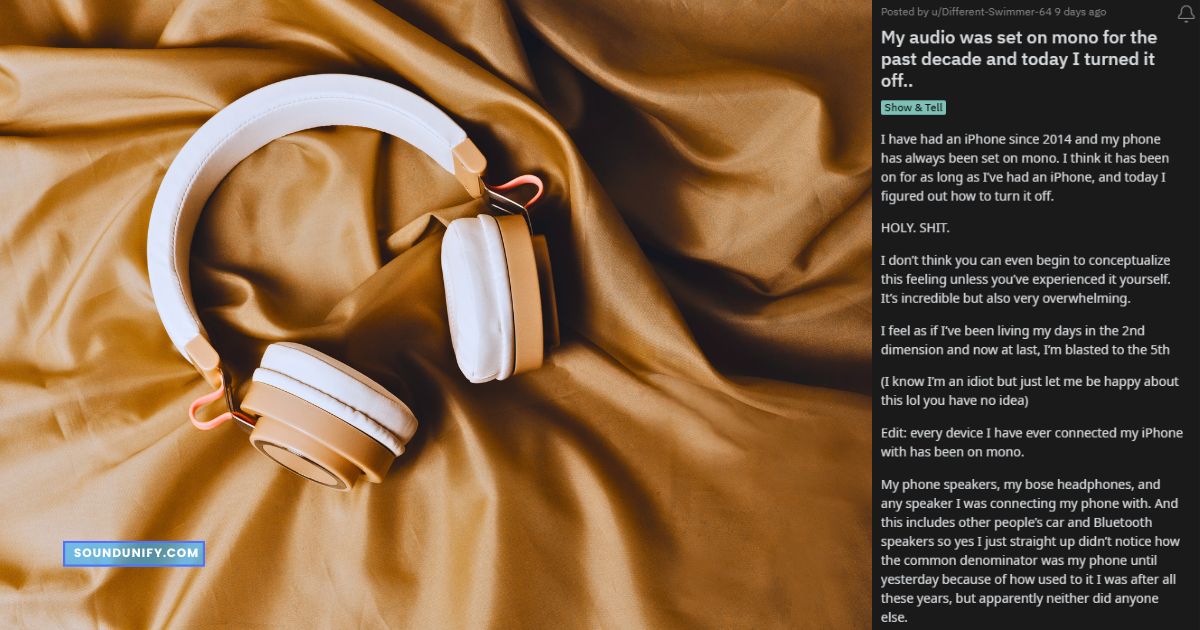In the world of audio, two terms frequently pop up: mono and stereo. At their core, they distinguish between single-channel and dual-channel sound.
Mono, short for monophonic, merges all sounds into a single channel, offering the same audio from every speaker.
Stereo, on the other hand, uses two channels to create a richer, more immersive listening experience by varying the audio between the left and right speakers.
Enter the curious case of u/Different-Swimmer-64, a Reddit user whose iPhone odyssey took a turn for the auditory when they discovered their device had been set to mono for an entire decade.
Yes, you read that right. For ten years, every song, every video, every call sounded flat, confined to a single dimension of sound. The moment they switched to stereo, the veil was lifted, and the world of audio was reborn in all its dimensional glory.
This story is not just about a setting change; it’s about rediscovering the essence of sound itself.
The Discovery
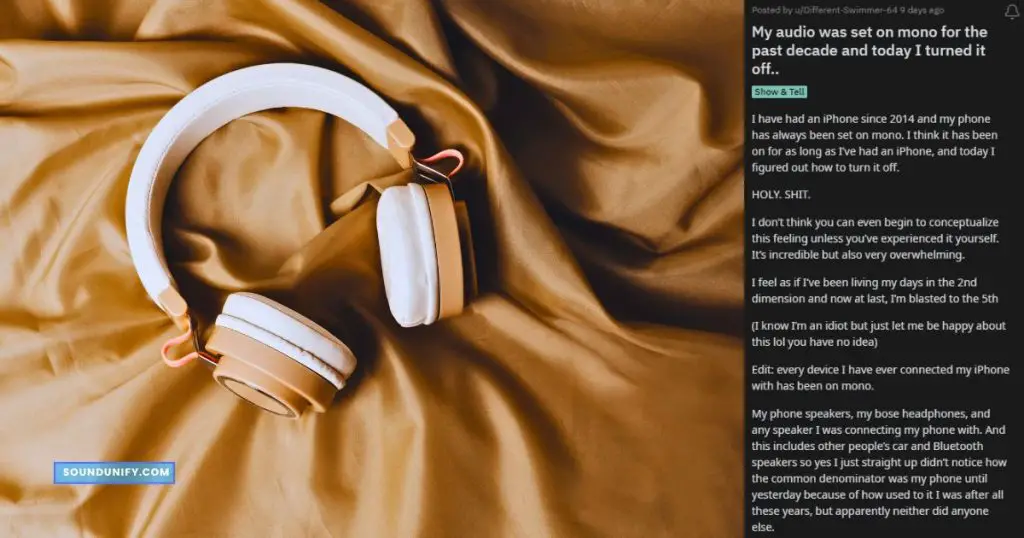
Imagine living a decade draped in an auditory veil, where every melody, every voice, and every sound from your iPhone melds into a singular, undistinguished stream. This was the world for u/Different-Swimmer-64, unknowingly entangled in the mono-setting simplicity.
The discovery came as an accidental revelation, a mere fiddling with settings, which peeled back a layer of sound they never knew was missing.
“HOLY. SHIT.” These were the words that spilled from their mouth, a concise testament to the shock and awe that washed over them. For ten long years, their ears had been confined to a monochromatic soundscape, unaware of the rich tapestry of stereo sound.
It was akin to seeing color for the first time after a lifetime in black and white. The switch to stereo wasn’t just a change in settings; it was an awakening.
The emotional response was immediate and overwhelming. There was joy, of course, the pure, unadulterated bliss of rediscovery. But beneath it lay a pang of regret — a decade of music, calls, and videos, all experienced through a bottleneck of sound.
Yet, as they navigated through their playlist, reliving songs in their newfound stereo glory, each track became an exploration, a journey through layers of sound they had never perceived. It was a sensory renaissance, a rebirth of appreciation for the art of sound.
Community Response
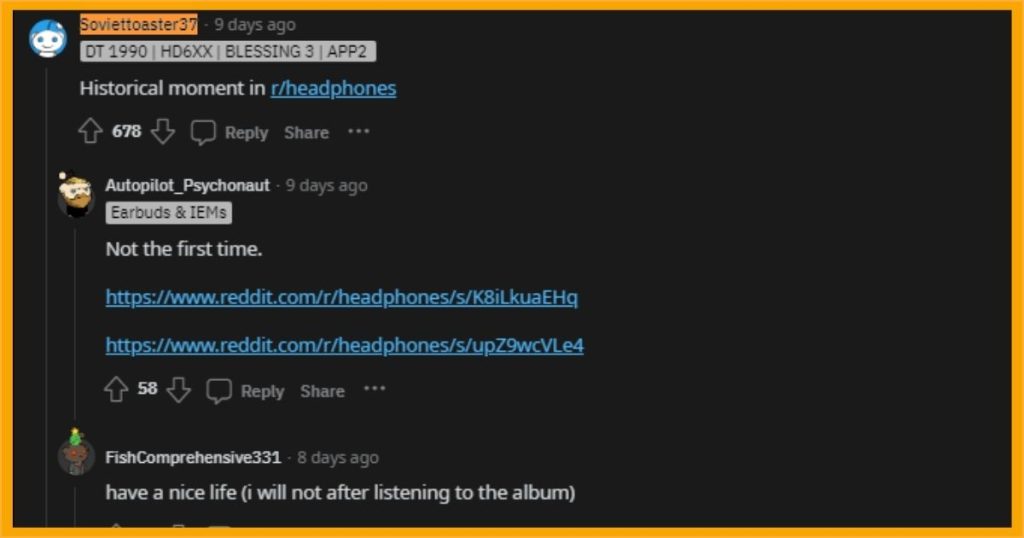
The revelation shared by u/Different-Swimmer-64 struck a chord within the Reddit community, eliciting a symphony of responses that ranged from empathy to astonishment and even to self-reflection. Fellow Redditors rallied with support, sharing their tales of audio misadventures and the lessons learned along the way.
One user, Soviettoaster37, hailed the moment as a “historical moment in r/headphones,” encapsulating the collective amazement at such a simple yet profound discovery. This sentiment echoed through the thread, as many couldn’t fathom the notion of experiencing a decade in mono.
Digitalanalog0524 asked the question on many minds: “Why was it set to mono in the first place?” This query opened the floodgates for technical discussions, with users like monetary read sharing their reasons for toggling mono audio, from listening to poorly mixed podcasts to addressing hearing imbalances.
A pivotal moment came when Monetary Read shared, “This post just reminded me to turn Mono off on my PC.” Their comment became a beacon, prompting others to dive into their settings, uncovering their mono settings that had gone unnoticed for years.
Anecdotes poured in, with users like yungGoldscar sharing personal reasons for using mono audio due to hearing loss, adding depth to the discussion and highlighting the accessibility aspect of mono sound.
The thread wasn’t just a space for shared astonishment; it turned into a collective troubleshooting session. VoicesToldMeToSignUp provided a step-by-step guide on locating and adjusting the mono audio setting, transforming the conversation into a hands-on workshop for better sound.
Amid the technical talk and shared experiences, a unifying message emerged: a reminder of the importance of exploring and understanding our devices’ settings. This wasn’t just about stereo sound; it was a lesson in mindfulness, in paying attention to the details that shape our daily experiences.
Through empathy, technical advice, and shared stories of discovery, the Reddit community turned a simple post into a profound communal learning experience.
The Importance of Audio Settings
The saga of u/Different-Swimmer-64’s audio enlightenment underscored a crucial facet of our digital lives: the profound impact of audio settings on our listening experience.
The mono versus stereo debate isn’t just a matter of preference; it’s a gateway to how we perceive and interact with sound, transforming our connection with music, movies, and even everyday conversations.
- Mono sound, often seen as the more straightforward sibling, ensures uniformity in audio delivery, making it indispensable in environments where accessibility is critical or when dealing with certain auditory conditions. Yet, it compresses the soundstage, merging all nuances into a single channel, thus simplifying the complexity of audio compositions.
- Stereo sound, on the other hand, offers a dimensional soundscape, allowing sounds to breathe and exist in a more natural state. It mimics the human ear’s ability to discern directionality and distance, enriching the listening experience by delivering audio in a way that envelops the listener, creating a sense of immersion that mono simply cannot replicate.
Acoustic engineers and audio enthusiasts in the Reddit thread shared valuable insights into this dichotomy. Oratory1990, an acoustic engineer, shed light on the nuances of sound engineering, emphasizing how stereo recordings can enhance the emotional impact of music by exploiting spatial cues, a technique mono recordings can’t achieve.
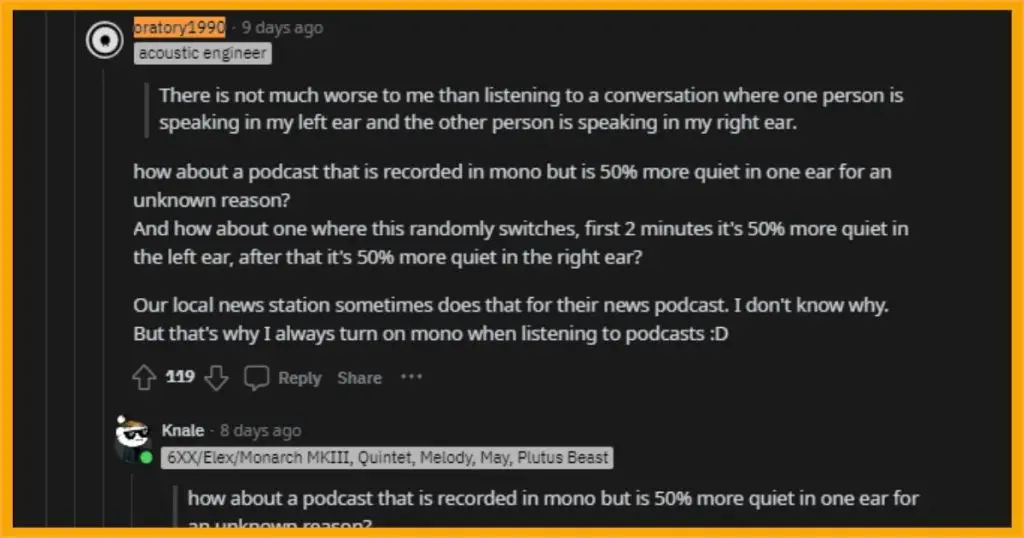
The thread also delved into practical advice for optimizing audio settings. Enthusiasts pointed out that while stereo offers a richer experience, specific scenarios, such as listening to a voice-only podcast or using a single earbud, might benefit from the simplicity of mono.
This led to discussions on the importance of context in choosing audio settings, highlighting that awareness and intentionality in setting adjustments can significantly elevate the listening experience.
The consensus among the community was clear: understanding and experimenting with audio settings can unlock a new realm of auditory delight. Whether it’s the immersive depth of stereo or the focused clarity of mono, the choice of audio setting is a powerful tool in shaping how we experience sound, urging listeners to venture beyond the default settings and explore the sonic landscapes waiting to be discovered.
Personal and Technical Implications
The journey of u/Different-Swimmer-64 from a mono to a stereo soundscape not only unraveled an auditory revelation but also highlighted the intricate dance between personal habits, technical settings, and their impacts on our digital experiences.
The Mono Mystery
For u/Different-Swimmer-64, the decade-long mono setting was a fortunate mistake, likely rooted in a moment of curiosity or a misstep in navigation through the iPhone’s settings.
This anecdote serves as a poignant reminder of how a simple tweak, forgotten in the whirlwind of daily life, can morph into a longstanding habit, shaping our interaction with technology in ways we scarcely notice.
Mono audio, while seemingly a downgrade at first glance, holds its ground in specific contexts. It ensures that individuals with hearing impairments or those who often use a single earbud can receive all audio content without losing half the stereo mix.
Moreover, in environments where audio quality and directionality are compromised, like:
- Noisy public spaces.
- Mono can deliver a more transparent.
- A more understandable listening experience.
Navigating Audio Settings
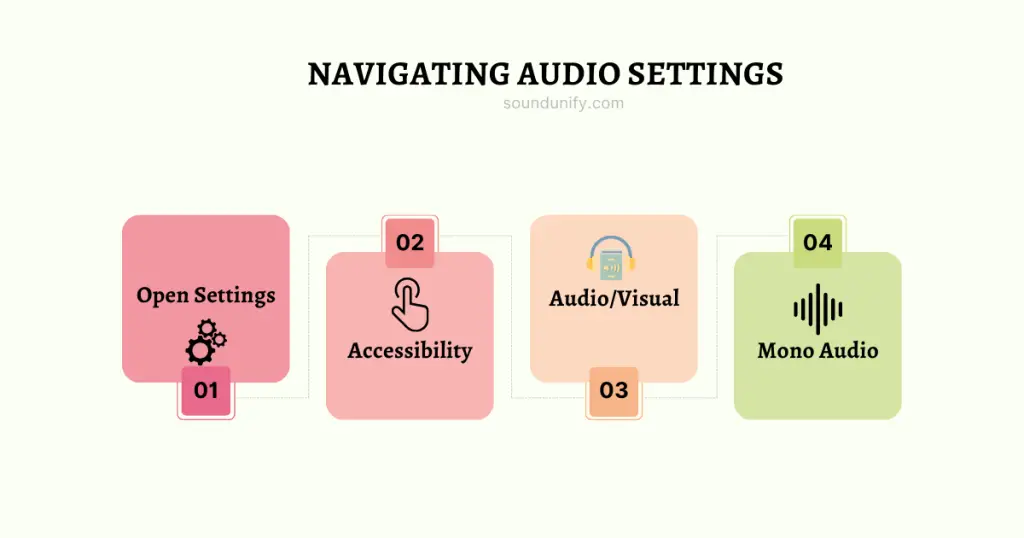
Adjusting audio settings from mono to stereo (or vice versa) is a straightforward process that can dramatically alter one’s listening experience. Here’s a step-by-step guide for iPhones, with parallels in other devices:
- Open Settings: The gateway to your device’s customizable features.
- Accessibility: Apple’s dedication to inclusivity shines here, where you’ll find options tailored for various needs, including audio adjustments.
- Audio/Visual: This submenu houses the crucial setting—Mono Audio. By default, iPhones utilize stereo sound, but this toggle allows users to switch to mono, combining the left and right audio channels into a singular stream.
- Toggle Mono Audio: Switch this option off to embrace the whole, rich stereo experience that u/Different-Swimmer-64 celebrated. For those who find mono audio more practical or necessary, keeping this option on ensures audio is accessible and enjoyable in any situation.
For users of other devices, a similar path through the settings menu—often under “Sound” or “Accessibility”—will lead to equivalent audio configuration options. It’s a universal feature across modern smartphones, reflecting a commitment to accommodating diverse listening preferences and needs.
Embracing Audio Diversity
This tale from the digital soundscapes reminds us of the power vested in the minutiae of settings.
By exploring and understanding these options, users can tailor their devices to suit personal preferences and situational needs or even overcome limitations, transforming the mundane into a symphony of personalized tech harmony.
Whether you’re an audiophile craving the depth of stereo or someone who leans on the clarity of mono, the key lies in the palm of your hand, a few taps away.
Broader Perspective Reflections on how easy it is to overlook basic settings that can significantly impact our daily experiences. Comments on the evolution of audio technology and how it shapes our interaction with media.
Broader Perspective
The odyssey of u/Different-Swimmer-64, transitioning from a decade of mono to the immersive world of stereo sound. Serves as a profound reminder of how the most straightforward settings on our devices can dramatically reshape our daily experiences.
This story transcends audio preferences, touching upon a universal truth: the minutiae of technology, often overlooked, hold the power to transform our interaction with the digital world.
1. The Overlooked Details
In the fast-paced rhythm of modern life, it’s easy to set and forget. We often need to pay more attention to basic settings, not realizing the extent to which they can enhance or diminish our digital experiences.
The mono-to-stereo revelation underscores the importance of revisiting and reassessing our device settings, encouraging a more mindful and intentional approach to technology.
It’s a nudge to explore beyond the surface, to tweak and tailor until our digital experiences align perfectly with our personal preferences and needs.
2. The Evolution of Audio Technology
The journey of audio technology from mono recordings to the rich landscapes of stereo and beyond into surround sound and spatial audio highlights. This is not just technological advancement but a deeper understanding of human sensory perception.
Each leap forward in audio technology has brought us closer to replicating the full spectrum of human hearing, transforming how we interact with media.
Stereo sound, with its ability to mimic the spatial cues of the natural world, has revolutionized music production, filmmaking, and even everyday content consumption, offering a more immersive, realistic experience.
With the advent of spatial audio and 3D sound, this immersion deepens further, enveloping the listener in a sound environment that feels as vast and varied as the world around them.
3. Shaping Our Interaction with Media
As audio technology evolves, so too does our interaction with media. Stereo sound has shifted from a novel experience to a baseline expectation, influencing not just what we listen to but how we listen.
The fidelity and depth of stereo have become integral to the enjoyment of music, the understanding of film narratives, and the immersion in virtual environments.
FAQs on Mono and Stereo Sound Settings
What is the difference between mono and stereo sound?
Mono (monophonic) sound channels audio through a single channel, delivering the same sound to all speakers or headphones. Stereo (stereophonic) sound uses two or more channels to create a richer and more immersive listening experience, allowing for spatial distinction between sounds making it feel like they’re coming from different directions.
How can I change between mono and stereo audio settings on my device?
For iOS devices: Go to Settings > Accessibility > Audio/Visual > Mono Audio and toggle it off for stereo sound.
For Android devices: Navigate to Settings > Accessibility > Hearing > Mono audio and switch it off to enable stereo.
The exact path may vary slightly depending on your device model and operating system version.
Why would someone prefer mono sound over stereo?
Accessibility reasons: Individuals with hearing loss in one ear might prefer mono to ensure they don’t miss part of the audio delivered to the ear with less hearing ability.
Specific listening conditions: Mono can be beneficial in environments where it’s hard to appreciate stereo separation, like in noisy areas or when using a single earbud.
Content type: Some content, like specific podcasts or audiobooks, might benefit little from stereo separation and can be enjoyed in mono without losing quality.
Does changing to mono sound affect battery life?
The impact on battery life is negligible. Processing stereo or mono audio doesn’t significantly affect battery consumption on modern smartphones or audio playback devices.
Can all devices switch between mono and stereo?
Most modern devices with an operating system (smartphones, tablets, computers) offer the option to switch between mono and stereo sound. However, the ability to change these settings on specific standalone audio devices, like some headphones or speakers, might be limited or nonexistent.
Is there a quality difference between mono and stereo recordings?
The quality of a recording could be better in stereo or mono, but it pertains to how the audio is experienced. Stereo recordings can offer a more immersive and realistic listening experience due to the spatial effects. Mono recordings can sometimes sound more direct and clear, especially in non-ideal listening environments.
Can I switch my home audio system between mono and stereo?
Many home audio systems allow you to configure your speakers for mono or stereo output through the system’s settings or setup menu. Check your system’s manual for specific instructions, as the capability and method can vary widely depending on the make and model.
Does listening in mono vs. stereo affect my headphones?
Headphones will play back audio in the format they receive. Switching between mono and stereo doesn’t affect the headphones themselves but changes how the listener perceives the sound.
Conclusion
The journey of u/Different-Swimmer-64, from a decade-long mono experience to the vibrant world of stereo sound, underscores a profound truth: the most superficial changes can lead to the most transformative experiences. This story is a testament to the power of exploration and understanding in our interaction with technology. It’s a reminder that within the maze of settings on our devices lies the potential to enhance our digital lives drastically.
Let this narrative inspire you to dive into your settings, to tinker, and to discover. Share your stories of audio revelations or any other setting discoveries that reshaped your experience. Who knows? Your journey could be the beacon that lights the way for others in their quest for a more prosperous, more immersive digital world. Explore, experiment, and share—the subsequent great discovery could be just a setting away.
James Dimento is a Chief-in-Editor of SoundUnify. He is a headphone enthusiast and creative writer passionate about audio technology. He has three years of experience writing about headphones and sound quality and is responsible for creating reviews and taking care of all administration.
